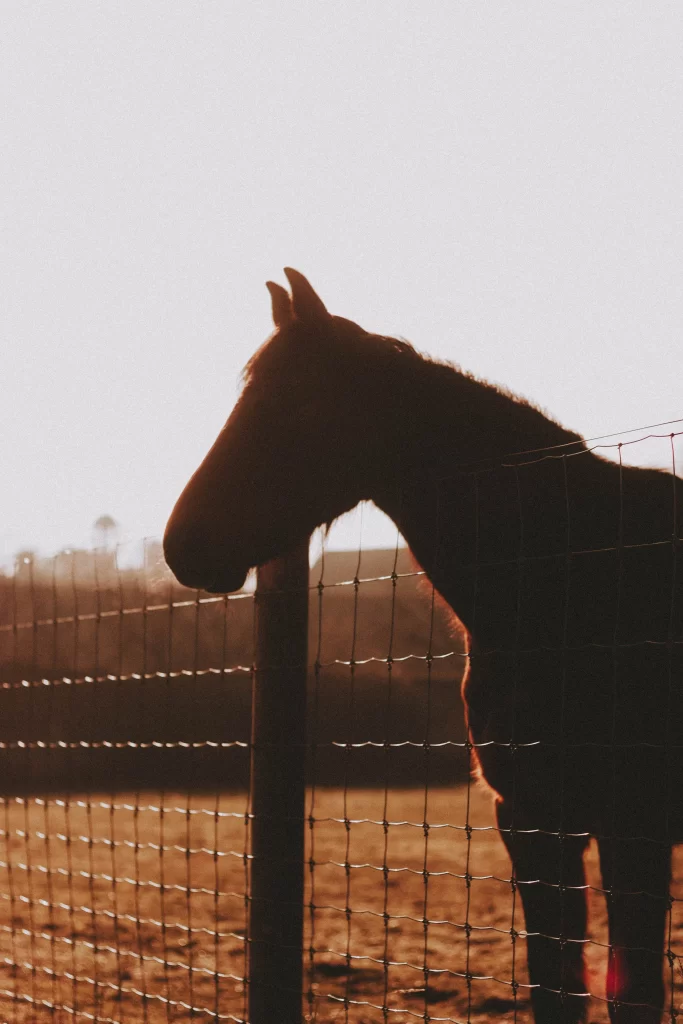Field
U Post Vs T Post: What IS The Big Difference Anyways?
With the variety of fence posts on the market, each with its own pros and cons, it can be difficult to choose the appropriate fence post for your situation.
As their main function is to support the fence, choosing the best fence post depends on your fencing, the type of land, the animals you are raising, and your budget.
In this article, we are going to clarify the difference between T post vs U post, the two most popular types in the hope of giving you some guidance.
*This post may have affiliate links, which means I may receive commissions if you choose to purchase through links I provide (at no extra cost to you). As an Amazon Associate I earn from qualifying purchases. Please read my disclaimer for additional details.
U Post Vs T Post
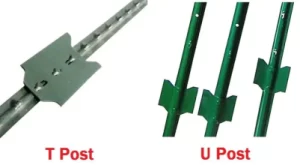
The big difference between T posts and U posts resides in how they can be used.
T posts are primarily used for poultry or gardens and can be easily removed whereas U posts are used for larger animals and can withstand rugged conditions.
What Is A U Post?
U posts are multipurpose pickets widely used in the US. They are shaped like a “U” and have punched holes that allow the wire to run straight through them.
They are quicker to install but do require being pounded into the ground.
What Is A T Post?
Metal T posts are punched or studded and require wire clips so they can be securely attached to fencing wire.
The “T” acts as an anchor in the ground to keep the post securely buried and because it doesn’t need to be pounded into the ground, it can be easily removed and reused.
Read More: Is a Swan and a Goose the Same Thing? We cover the differences between these two waterfowl!
Types Of Fence Posts
1. Wooden Fence Posts
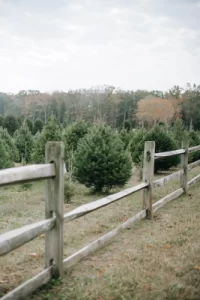
Wooden fence posts can be a great option for various types of wooden and wire fencing.
In order to keep wood posts vertically fixed and maintained, it is important to dig holes and then surround them with gravel OR fill holes with cement so that they are sturdy and durable.
It is subject to the ground types that you need to build a deep hole, especially if it is full of soil.
One of the advantages of this type of wooden fence post is that it brings an aesthetically pleasing appearance to your farm, but wooden fence posts can be much more expensive than metal fence posts.
However, for small animals and crop fencing, you may want to reconsider as wooden fences may not do a good job at keeping animals inside the boundary.
2. Metal Fence Posts
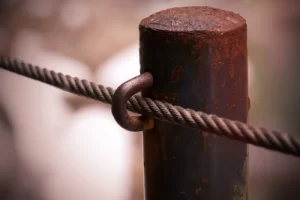
In comparison with wooden fence posts, metal fence posts are more affordable and an easier-to-install alternative.
Steel fence posts are the most popular metal posts available but don’t count them out after analyzing your crops, livestock, and style of fencing you want.
Though they do not seem to look equally nice as wood, they are more suitable for a spacious farm and are generally heavier duty.
When it comes to metal fence posts, there are various shapes, but the two most popular ones are the T post and the U post.
U Post Vs T Post Characteristics
1. Price
U posts are often half of the price of T posts, starting at around the $4 (USD) mark for a single U post compared to a starting price point of around $6 to $7 (USD) for one T post.
2. Thickness
There are a number of options for T and U posts, including heavy and light-duty versions.
U posts are often heavier duty and often used for farms with goats and ponies while T posts are more appropriate to protect poultry.
Another point to keep in mind is that T posts are easy to install and remove if necessary but U posts are usually thicker and farmers usually have to pound them in the ground to keep them steady.
Also, some farmers shared that ponies and goats often lean on T-posts, bending or pushing them outward.
Overall though, the thickness of T posts and U posts are pretty similar, ranging from 2 mm to 6 mm.
3. Package(s) Available
T and U posts are often sold in bundles of 10 pieces and in pallets of 50 bundles, but can also be purchased in singles.
4. Applications And Uses
Apart from their fencing function, metal T and U posts can be used to protect gardens and houses, support wire mesh fencing, fix plants AND secure traffic signboards, etc.
T posts are primarily used to support wire fencing material and have an anchor at the bottom that digs into the ground to keep them in the ground.
U posts, on the other hand, are used for multiple purposes, including but not limited to securing temporary fencing for temporary pastures, fixing plants, or even supporting young trees and plants.
However, U posts are usually used as an anchor plate for securing agricultural fencing to keep livestock safe from predators.
6. Other Differentiating Characteristics
Advantages of U posts:
- Cheap but good quality
- Avoid chipping and bending caused by the rugged environment
- Long-lasting
Advantages of T posts:
- Very convenient to attach the wire
- Higher earth grasping strength
- Can be reused
- Is more robust and generally heavier duty
How Do You Install Steel Fence Posts?
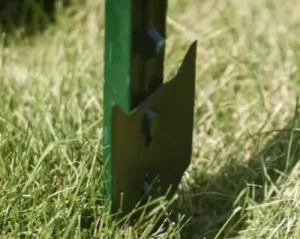
Step 1 – Consider options and Go shopping
The first step is to consider all the “T” and “U” posts options available and select among various types of steel fence posts.
Then, based on the total length of the fence you need and the distance between posts, determine how wide and tall you would like each post to be.
Tip: It is suggested that posts should be about 2 feet taller than the fence.
Once you have determined all the options and required length, it is time to buy the pertinent number of posts once your calculation is done.
Step 2 – Map the Location of Post Spots
Locate designated areas for post spots.
Once the location has been determined, this will help you find out how far the posts will be from each other and how long your fence is.
Then measure the same distance between posts and start digging holes.
For some ground types full of rocks and obstacles, it will be necessary to shovel and clear them before the installment to make sure that all posts are at the same height.
Step 3 – Make Holes for Post Spots
In order to accelerate the work, employ the best auger for fence posts to make holes where posts will be located.
Tip: Regardless of U Post vs T Post, each hole should be at least 2 to 2 1/2 feet deep.
Step 4 – Secure Posts to Stakes
Securely attach posts to stakes by inserting small and thin metal posts underground in each post hole.
Step 5 – Pull a String Around the Area
Next, wrap around the area of the fence with string to inspect possible obstacles. Remove any before moving on.
Step 6 – Fill the Holes
Fill the holes with gravel or dry cement but only fill holes about 2/3rds of the way.
Step 7 – Fit the Posts in Holes
Insert and press a post down into each hole. Make sure the post is then wrapped in gravel and firm.
If you want to check whether it is kept upright or slightly tilted, use a leveling tool. Before continuing the next step, all posts should be securely anchored.
Step 8 – Fill the Holes with Cement Mixture
Once all posts are securely anchored, have the cement mixed and fill the holes with the mixture by pouring the cement into the remaining spaces.
Wait until they are dry before moving on to the next post for lifelong steadiness.
Step 9 – Strengthen Posts
To increase sturdy support for posts, secure them with more stakes or wires around the base of the posts.
Though this task is not compulsory, it can yield a long-lasting fencing structure and eliminate the possibility of a weak and shaky one.
A shaky and small post will not be able to stand up to a rugged environment and withstand animals that like to lean against or jump over their fencing.
A fence of big and dense posts will provide animals a protective wall but may be overkill and very time and money-consuming.
By pointing out the difference between T posts and U posts, we hope to help you find your answer as to which one you should use in your situation.
No matter what type you choose, remember that a post can serve as the spine of your fencing. The sturdier the post, the stronger the fence.
FAQs
What is better – U post vs T post?
One is not necessarily better than the other. It just depends on your situation, your land, your budget, and why you even need a post to begin with.
If you need a finished fence for large animals, a U post is a great option, whereas a T post would be a great option for gardens, poultry, and homes.
Is a T post or a U post stronger?
Because U posts tend to be used when fencing larger animals, U posts need to be generally heavier duty than T posts.
How long will metal T-posts last?
Depending on the type of soil you are putting your metal T-posts in, these posts generally will last 10 to 20 years. The more acidic your soil, the more likely it will have a lower average lifespan.
Can you use T-posts for a wooden fence?
Yes, you can use a T post for wooden fences. In fact, it might be easier, easier on your budget, and last longer than using wood posts as they do not rot in the ground.
How tall should a T post be for a horse fence?
When using a T post for a horse fence, it is recommended that your T post be 54 to 60 inches above the ground.
It is also recommended to space your T posts 10 to 12 feet apart.
How do you install a metal post in the ground?
If you are wanting to install a metal fence post in the ground, you can use a manual posthole digger like a shovel, or an auger.
How do you install a metal fence post on concrete?
If you need to install a metal fence post on concrete, the easiest and quickest method is to use an anchor plate to mount the post.
How much concrete do I need for a steel fence post?
Typically, and depending on your soil, post size and height, and weight of the concrete bag, each post hole will need 1 to 4 bags of concrete.
Gate fence posts will require more concrete due to how often they are utilized.
How do you drive fence posts into the ground?
You can drive a fence post into the ground using a manual or automatic post driver (also known as a post-pounder).
